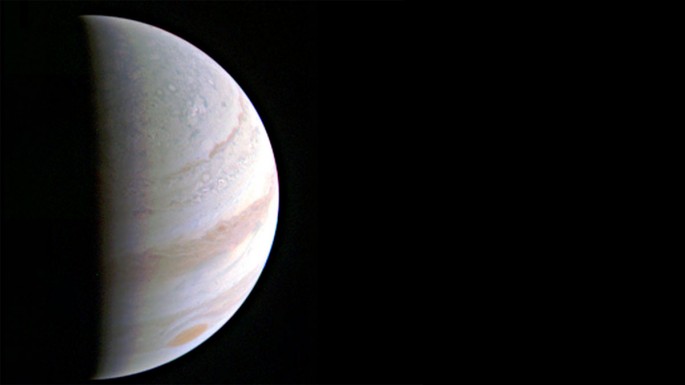NASA announced its Juno spacecraft successfully executed the first of 36 orbital flybys of Jupiter on Aug. 27.
It said the time of Juno's closest approach to the solar system's largest planet and gas giant took place at 13:44 UTC when Juno passed about 4,200 kilometers above Jupiter's tormented clouds. Juno was traveling at 208,000 kilometers per hour with respect to the planet at the time.
This flyby was the closest Juno will get to Jupiter during its prime mission. Juno is scheduled to reach the end of the mission during its 37th orbit and perform a controlled deorbit. It will then disintegrate into Jupiter's atmosphere.
Juno stands for "JUpiter Near-polar Orbiter."
"Early post-flyby telemetry indicates that everything worked as planned and Juno is firing on all cylinders," said Rick Nybakken, Juno project manager at NASA's Jet Propulsion Laboratory in Pasadena, California.
There are 35 more close flybys of Jupiter planned during Juno's mission scheduled to end in February 2018. The August 27 flyby was the first time Juno had its entire suite of science instruments activated and looking at the giant planet as the spacecraft zoomed past.
Juno entered Jupiter's orbit on July 5, 2016, the prelude to 20 months of scientific data collection. The space probe was launched from Cape Canaveral Air Force Station on Aug. 5, 2011 as part of the New Frontiers program.
"We are getting some intriguing early data returns as we speak," said Scott Bolton, principal investigator of Juno from the Southwest Research Institute in San Antonio. "It will take days for all the science data collected during the flyby to be downlinked and even more to begin to comprehend what Juno and Jupiter are trying to tell us."
While results from the spacecraft's suite of instruments will soon be released, a handful of images from Juno's visible light imager -- JunoCam -- are expected to be released the next couple of weeks. Those images will include the highest-resolution views of the Jovian atmosphere and the first glimpse of Jupiter's north and south poles.
"We are in an orbit nobody has ever been in before, and these images give us a whole new perspective on this gas-giant world," said Bolton.
JPL manages the Juno mission for the principal investigator, Scott Bolton, of Southwest Research Institute in San Antonio. Juno is part of NASA's New Frontiers Program managed at NASA's Marshall Space Flight Center in Huntsville, Alabama, for NASA's Science Mission Directorate.
Lockheed Martin Space Systems, Denver, built the spacecraft. Caltech in Pasadena, California, manages JPL for NASA.



























